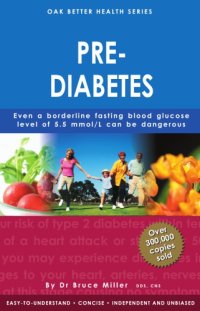
Ebook: Potential mechanisms for amelioration of type 2 diabetes following bariatric surgery
Author: Dohm G. Lynis, Reed Melissa Anne, East Carolina University. Department of Department of Kinesiology
- Tags: Kinesiology, Obesity--Surgery, Non-insulin-dependent diabetes, Gastric bypass, Academic theses, Obesity -- Surgery
- Year: 2011
- Publisher: East Carolina University
- City: Greenville;N.C
- Language: English
- pdf
Severe obesity and Type 2 Diabetes (T2DM) are worldwide health concerns reaching epidemic proportions. Roux-en-Y gastric bypass (RYGB) has been shown to elicit a rapid and durable improvement and/or remission of T2DM in as little as one week following surgery in approximately 80% of patients, however the exact mechanism(s) responsible for this remission remain unknown. It was the central hypothesis of this project that T2DM is rapidly ameliorated following RYGB in part by increasing skeletal muscle insulin sensitivity. Study One: To test this hypothesis we examined insulin sensitivity and insulin secretion in severely obese non-diabetic and T2DM women prior to RYGB and 1 week and 3 months post-RYGB using an insulin-modified intravenous glucose tolerance test (IVGTT) with Minimal Model analysis. Insulin sensitivity and insulin secretion were measured in lean women as a control group. One week after RYGB, insulin sensitivity in T2DM doubled compared to pre-RYGB but was still impaired (S₁ approximately 50% of lean controls) and insulin secretion was improved but not restored (AIRg approximately 50% of lean controls). Remarkably, fasting insulin decreased one week post-RYGB and was no different from lean controls in both the T2DM and non-diabetic groups in spite of continued elevated glucose in the T2DM patients compared to lean, suggesting that there is no longer a relationship between fasting insulin and glucose following RYGB. The main finding in this study was that RYGB reverses hyperinsulinemia, which is beneficial for a multitude of reasons. Hyperinsulinemia is a central factor in the cluster of disorders of the metabolic syndrome and is associated with increases in cardiovascular disease and overall all-cause mortality. Consistent with previous reports, approximately 25% of patients in Study One did not experience an improvement in their T2DM post-RYGB. The rapid reversal of hyperinsulinemia following RYGB and 25% non-resolution of T2DM led to two further questions: 1) Is it possible, pre-RYGB, to predict T2DM resolution following RYGB? and 2) Can hyperinsulinemia induce skeletal muscle insulin resistance? Study Two: To follow-up question number one we examined the T2DM cohort from Study One to determine the remission of T2DM following RYGB. Three patients exhibited complete T2DM remission 3 months post-RYGB (defined as fasting plasma glucose (FPG) <100mg/dL), three experienced improvement but FPG remained impaired (FPG of 100-125 mg/dL) and two patients did not experience improvement in their T2DM (FPG> 125 mg/dL). We found that pre-RYGB insulin sensitivity and duration of diabetes were significantly correlated with FPG at 3 months post-RYGB suggesting that preserving insulin sensitivity may be essential in the remission of T2DM following RYGB. Study Three: To investigate the effects of hyperinsulinemia on skeletal muscle, primary skeletal myotubes from lean (LN) (23.0 ± 1.7 kg/m²) insulin sensitive (HOMA-IR: 1.3 ± 0.3) and severely obese (OB) (41.4 ± 3.8 kg/m²) insulin resistant (HOMA-IR: 5.8 ± 1.1) individuals were exposed to physiological levels of hyperinsulinemia for 4 days. It was hypothesized that exposure to chronic hyperinsulinemia (5000 pM) would downregulate insulin signaling. Following the 4-day incubation, cells were exposed to a 15 minute acute supraphysiological (100nM) insulin stimulation to determine insulinstimulated insulin signaling. As insulin resistance is associated with mitochondrial dysfunction we also hypothesized that chronic hyperinsulinemia would decrease mitochondrial content and subsequently decrease fatty acid oxidation. Following the 4-day hyperinsulinemic incubation insulin signaling was not downregulated in either group as measured by Akt and AS160 phosphorylation. Rather, AS160 phosphorylation was increased in the LN, but not OB following chronic hyperinsulinema. Complete oxidation of fatty acids was significantly reduced and incomplete oxidation was significantly higher in OB compared to LN independent of insulin incubation. Mitochondrial content in myotubes was not different between the groups. These data suggest that lean insulin sensitive myocytes respond to chronic hyperinsulinemia by increasing AS160 phosphorylation. This response is not observed in cells from obese indicating that perhaps insulin sensitive myocytes exhibit a flexibility in response to hyperinsulinemia that is not present in insulin resistant myotubes suggesting that hyperinsulinemia-induced insulin resistance may not act through Akt and AS160. Together, these studies suggest that RYGB reverses hyperinsulinemia in as little as one-week following surgery, in spite of continued insulin resistance, indicating the regulation of insulin by fasting glucose is altered following RYGB. Clinically, preserving insulin sensitivity prior to RYGB appears to be important, as patients that exhibit greater insulin sensitivity prior to RYGB experience lower FPG post-RYGB. Additionally, cells from lean, insulin sensitive individuals were capable of responding to physiological hyperinsulinemia by increasing insulin signaling in response to an acute insulin stimulus whereas the cells from obese, insulin resistant individuals demonstrate an inability to respond to hyperinsulinemia.
Download the book Potential mechanisms for amelioration of type 2 diabetes following bariatric surgery for free or read online
Continue reading on any device:

Last viewed books
Related books
{related-news}
Comments (0)